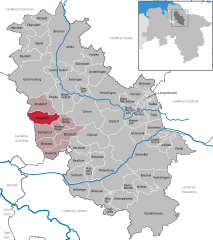Hepstedt
| Hepstedt | ||
|---|---|---|
| ||
 Hepstedt | ||
Location of Hepstedt within Rotenburg (Wümme) district 
 | ||
| Coordinates: 53°15′34″N 09°05′22″E / 53.25944°N 9.08944°ECoordinates: 53°15′34″N 09°05′22″E / 53.25944°N 9.08944°E | ||
| Country | Germany | |
| State | Lower Saxony | |
| District | Rotenburg (Wümme) | |
| Municipal assoc. | Tarmstedt | |
| Government | ||
| • Mayor | Werner Meyer | |
| Area | ||
| • Total | 29.95 km2 (11.56 sq mi) | |
| Elevation | 30 m (100 ft) | |
| Population (2015-12-31)[1] | ||
| • Total | 987 | |
| • Density | 33/km2 (85/sq mi) | |
| Time zone | CET/CEST (UTC+1/+2) | |
| Postal codes | 27412 | |
| Dialling codes | 04283, 04289 | |
| Vehicle registration | ROW | |
| Website | www.tarmstedt.de | |
Hepstedt is a municipality in the district of Rotenburg, in Lower Saxony, Germany.
Hepstedt belonged to the Prince-Archbishopric of Bremen, established in 1180. In 1648 the Prince-Archbishopric was transformed into the Duchy of Bremen, which was first ruled in personal union by the Swedish Crown - interrupted by a Danish occupation (1712-1715) - and from 1715 on by the Hanoverian Crown. In 1807 the ephemeral Kingdom of Westphalia annexed the Duchy, before France annexed it in 1810. In 1813 the Duchy was restored to the Electorate of Hanover, which - after its upgrade to the Kingdom of Hanover in 1814 - incorporated the Duchy in a real union and the Ducal territory, including Hepstedt, became part of the new Stade Region, established in 1823.
References
- ↑ Landesbetrieb für Statistik und Kommunikationstechnologie Niedersachsen, 102 Bevölkerung - Basis Zensus 2011, Stand 31. Dezember 2015 (Tabelle K1020014)
